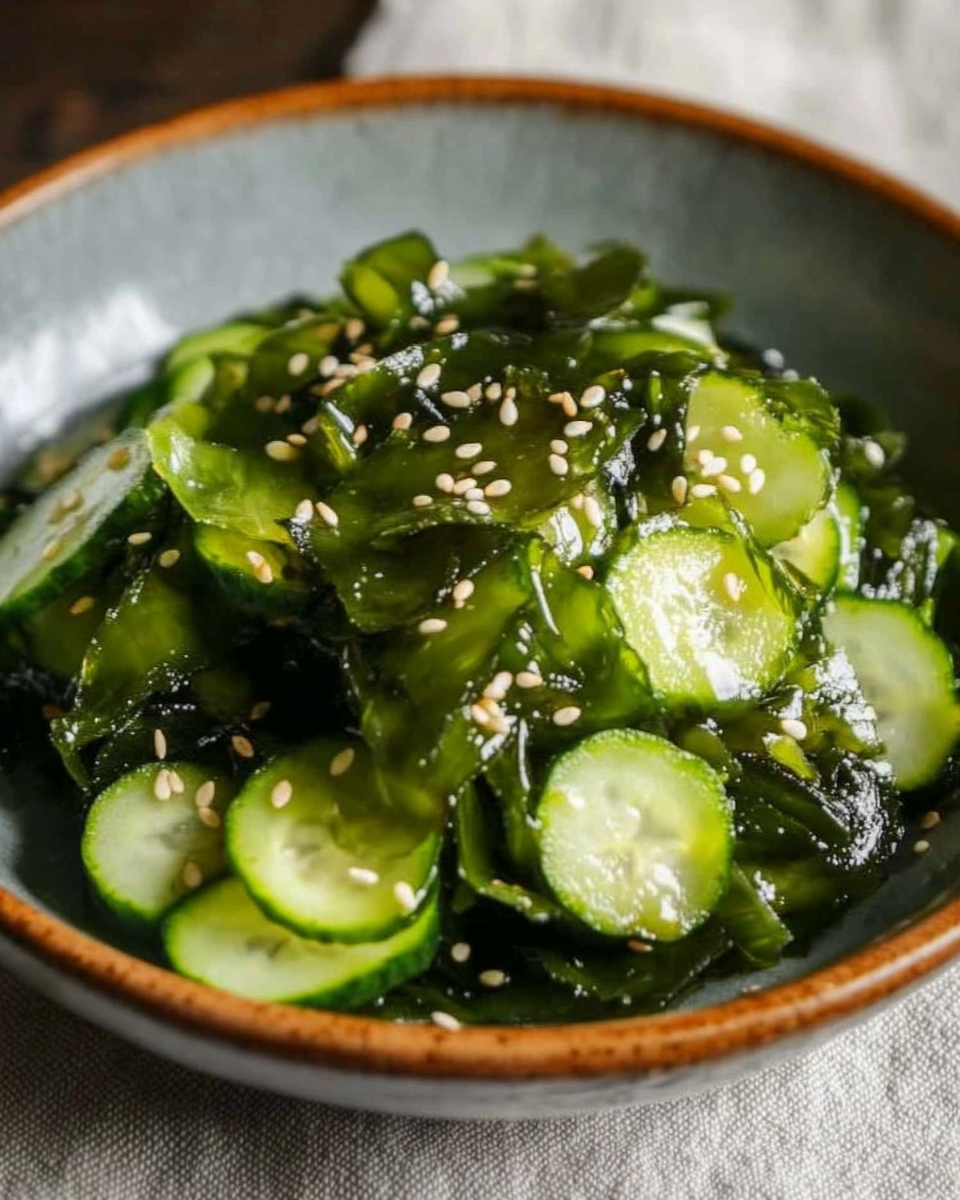This Japanese Cucumber and Seaweed Salad combines the crunchiness of fresh cucumbers with the savory depth of rehydrated seaweed. Tossed in a tangy soy sauce and rice vinegar dressing, it’s the perfect balance of refreshing and flavorful.
Whether you enjoy it as a light meal or a side dish, this salad offers a perfect combination of umami and freshness that’s both satisfying and nutrient-packed. Plus, it’s simple and quick to make—ideal for busy days when you want something light yet full of flavor.
Full recipe:
Ingredients:
-
2 Japanese cucumbers, thinly sliced
-
1/2 cup dried seaweed (wakame or hijiki)
-
1 tablespoon sesame seeds
-
1 tablespoon soy sauce
-
1 tablespoon rice vinegar
-
1 teaspoon sugar
-
1 teaspoon sesame oil
-
1/2 teaspoon salt
-
1/2 teaspoon freshly ground black pepper
-
Optional garnish: sliced chili peppers or shredded carrots
Directions:
-
Rehydrate the dried seaweed by soaking it in warm water for about 10 minutes. Drain and set aside.
-
In a small bowl, whisk together soy sauce, rice vinegar, sugar, sesame oil, salt, and pepper to make the dressing.
-
In a large mixing bowl, combine the thinly sliced cucumbers and rehydrated seaweed.
-
Pour the dressing over the cucumber and seaweed mixture, tossing gently to coat evenly.
-
Sprinkle sesame seeds over the salad and toss again.
-
Optional: Garnish with sliced chili peppers or shredded carrots for an extra burst of color and flavor.
-
Serve immediately or chill in the fridge for 30 minutes before serving.
Prep Time: 10 minutes | Cooking Time: 0 minutes | Total Time: 10 minutes | Kcal: 90 kcal | Servings: 2 servings
The Health Benefits of Cucumber and Seaweed
Cucumber, one of the key ingredients in this salad, is low in calories and high in water content, making it incredibly hydrating. It’s packed with vitamins like Vitamin K, which is essential for bone health, as well as a variety of antioxidants that help to reduce inflammation and support overall health. Cucumbers also provide a good dose of fiber, helping to promote digestion and keep you feeling full longer.
Seaweed, the other main ingredient in this salad, is a nutrient powerhouse. It is naturally rich in vitamins and minerals, particularly iodine, which is essential for thyroid health. Seaweed is also packed with antioxidants and has been shown to help improve heart health, boost metabolism, and support the immune system. It contains a variety of essential amino acids, making it a great plant-based source of protein. With its high fiber content, seaweed is also beneficial for digestion.
The combination of cucumber and seaweed offers a refreshing yet nutrient-dense salad that supports hydration, digestion, and overall well-being. Adding the light dressing of soy sauce, sesame oil, and rice vinegar not only enhances the flavors of these ingredients but also provides a burst of umami, which makes this salad even more appealing.
Perfect for Every Occasion
One of the great things about the Japanese Cucumber and Seaweed Salad is its versatility. It can be enjoyed on its own as a light, refreshing snack or served as a side dish to complement a larger meal. It pairs beautifully with sushi, grilled meats, or other Japanese dishes like miso soup and teriyaki chicken. The crispness of the cucumber and the savory notes of the seaweed make it the perfect balance to richer, heavier dishes.
This salad also makes a great addition to a light summer meal or picnic. Its bright flavors and cooling properties make it a wonderful choice for warm weather. Additionally, since it’s incredibly easy to prepare and requires minimal cooking, it’s the perfect dish for busy weeknights when you want something healthy and satisfying without spending too much time in the kitchen.
Customization Options for the Salad
While this Japanese Cucumber and Seaweed Salad is delicious as is, it also offers plenty of opportunities for customization. For example, if you like a little extra spice, you can add sliced chili peppers or a small drizzle of chili oil to the dressing. If you want to add more texture, consider sprinkling some toasted sesame seeds or chopped nuts on top. You can also experiment with different types of seaweed, such as wakame, hijiki, or kombu, to discover the flavor profile you prefer.
For those who follow a vegan or plant-based diet, this salad is already a fantastic choice. The dressing, made from soy sauce, sesame oil, and rice vinegar, is naturally vegan-friendly. However, if you prefer a sweeter or tangier dressing, you can easily adjust the ingredients. Adding a little maple syrup or agave nectar instead of sugar, or incorporating lemon juice instead of rice vinegar, are great ways to tweak the flavors to suit your taste.
How to Serve the Japanese Cucumber and Seaweed Salad
This salad is best served cold or chilled. If you plan to make it ahead of time, simply prepare the salad, toss it with the dressing, and let it sit in the refrigerator for about 30 minutes to allow the flavors to meld. This also helps the cucumbers to slightly soften and soak in the dressing.
When it’s time to serve, you can garnish the salad with additional toppings like sesame seeds, shredded carrots, or even fresh herbs such as cilantro or mint to give it a fresh, vibrant touch. If you like a more substantial salad, you can also add sliced avocado or edamame for added protein and healthy fats.
For a more indulgent version, feel free to top the salad with a poached egg or a drizzle of soy-based mayonnaise. These additions will bring even more richness and depth to the dish, creating a fuller experience without losing the light, refreshing nature of the salad.
The Cultural Significance of Japanese Cucumber and Seaweed Salad
In Japanese culture, salads are often served as side dishes, complementing the main course without overshadowing it. This Japanese Cucumber and Seaweed Salad follows this tradition by being a simple yet flavorful accompaniment to other dishes. It reflects the Japanese principle of balance, offering a harmonious blend of textures and tastes. The use of fresh vegetables, seaweed, and a light dressing represents the Japanese approach to eating—emphasizing fresh, seasonal ingredients that highlight natural flavors.
The salad’s connection to seaweed also ties it to the long-standing tradition of incorporating sea vegetables into Japanese cuisine. Seaweed has been a staple in Japan for centuries and is featured in many dishes, from sushi to soups. It holds a revered place in Japanese cooking due to its unique flavor and health benefits.
Why You Should Add Japanese Cucumber and Seaweed Salad to Your Meal Plan
This Japanese Cucumber and Seaweed Salad is a quick, nutritious, and flavorful addition to any meal. It’s an excellent choice for those looking to eat more vegetables and boost their intake of minerals and antioxidants. Plus, it’s incredibly easy to prepare, making it a great option for busy individuals who want to enjoy a healthy meal without spending too much time in the kitchen.
The salad is also versatile, allowing for a range of variations to suit your preferences and dietary restrictions. Whether you’re vegan, gluten-free, or simply looking for a light and refreshing dish, this Japanese Cucumber and Seaweed Salad has something for everyone.
Conclusion
The Japanese Cucumber and Seaweed Salad is a perfect balance of fresh, light, and savory flavors, making it an excellent choice for a healthy and satisfying dish. Whether you’re new to Japanese cuisine or a seasoned enthusiast, this salad offers a taste of Japan that’s easy to recreate at home. Its health benefits, versatility, and quick preparation make it a go-to recipe for anyone looking to enjoy a nutritious meal or side dish.
With its refreshing crunch and umami-packed dressing, this salad will quickly become a favorite in your culinary repertoire. It’s a wonderful addition to any meal, offering a burst of flavor and nourishment that will leave you feeling satisfied and energized. Try it today and experience the vibrant flavors of Japan in the comfort of your own kitchen.






